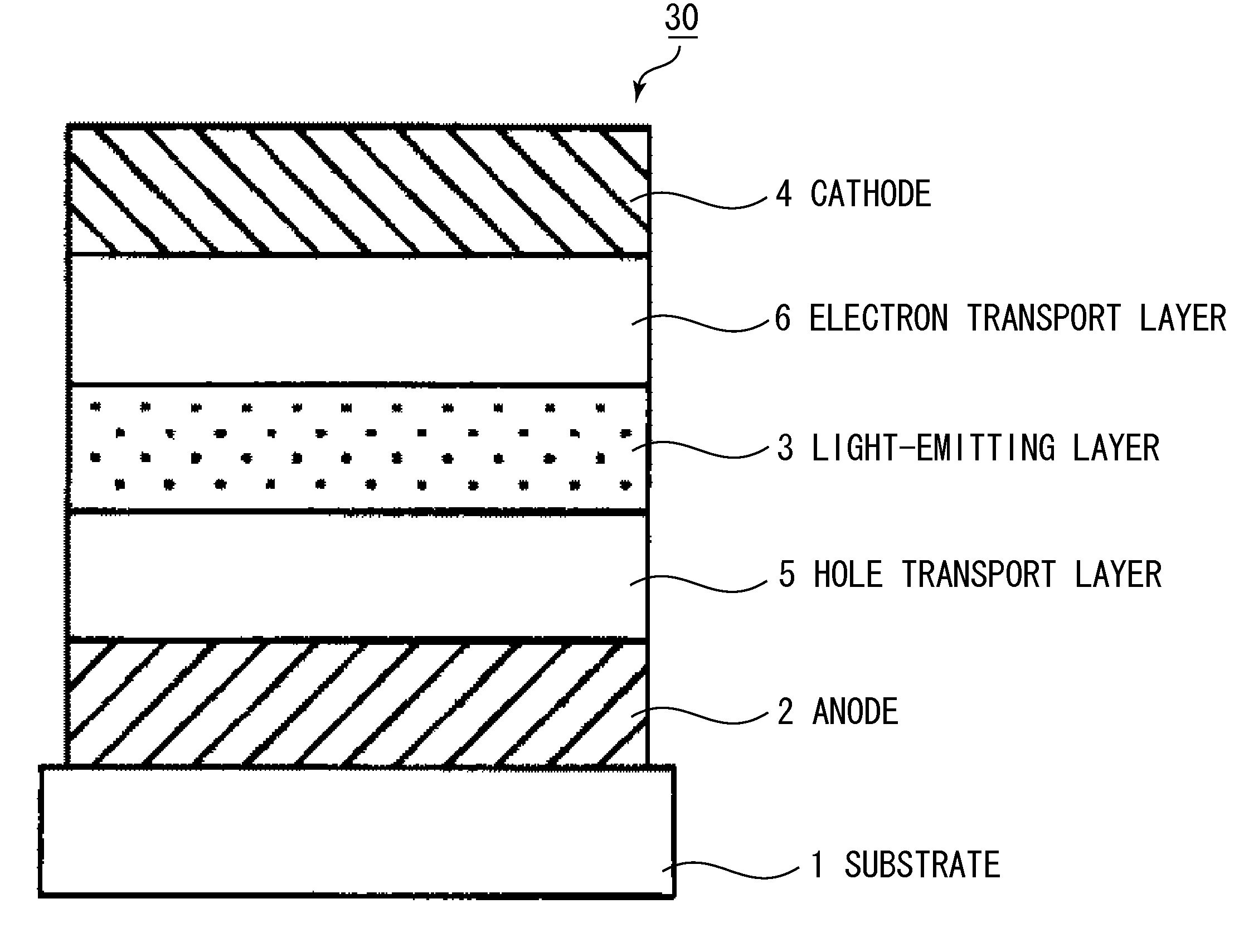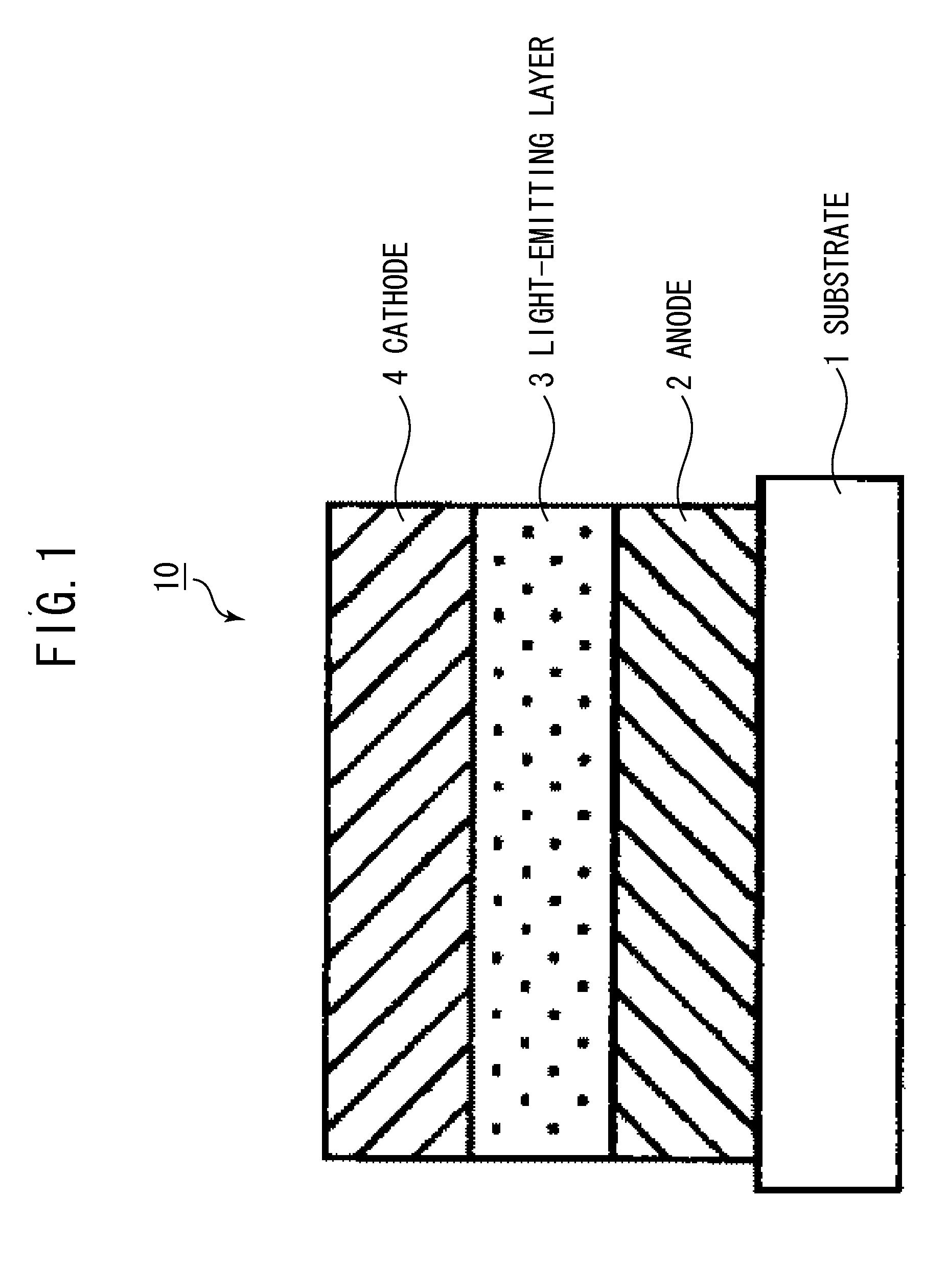Organometallic complex and organic light-emitting element using same
a technology complexes, which is applied in the direction of cadmium organic compounds, group 3/13 element organic compounds, discharge tubes luminescnet screens, etc., can solve the problems of low emission efficiency of organic light-emitting elements disclosed in these documents, insufficient durability, and time-consuming and labor-intensive problems, etc., to achieve high efficiency, prolong the effect of durability and high luminan
- Summary
- Abstract
- Description
- Claims
- Application Information
AI Technical Summary
Benefits of technology
Problems solved by technology
Method used
Image
Examples
example 1
Synthesis of Example Compound 17
[0083]
[0084](1) The following reagents and solvents were charged into an eggplant type flask with a capacity of 300 mL.[0085]Compound 1-1: 7.1 g (58 mmol).[0086]Compound 1-2: 5.0 g (39 mmol).[0087]Tetrakistriphenylphosphine palladium: 3.46 g (2.99 mmol)[0088]2M aqueous solution of sodium carbonate: 50 mL.[0089]Ethanol: 20 mL.[0090]Toluene: 50 mL.
[0091]The reaction liquid was stirred for 6 h under heating and refluxing under a nitrogen gas flow. After the reaction, the reaction solution was cooled to room temperature and separated by adding 50 mL of toluene. An organic layer was then isolated, and the organic layer was then concentrated under reduced pressure. The concentrated substance was purified by silica gel column chromatography (developing solvent: toluene), thereby obtaining 6.22 g of Compound 1-3 (yield 82%).
[0092](2) The following reagents and solvents were charged into a three-neck flask with a capacity of 100 mL.[0093]Iridium (III) chloride...
example 2
Synthesis of Example Compound No. 3
[0104]
[0105]The following reagents and solvent were charged into a three-neck flask with a capacity of 100 mL.[0106]Compound 1-3: 1.2 g (7.11 mmol).[0107]Example Compound No. 17: 1.5 g (2.37 mmol).[0108]Glycerol: 30 mL.
[0109]The reaction solution was then stirred for 8 h under heating at a temperature close to 180° C. under a nitrogen flow. Upon completion of the reaction, the reaction solution was cooled to room temperature. The reaction solution was then poured into 170 mL of 1N hydrochloric acid, and the precipitated sediment was filtered out, washed with water and vacuum dried for 5 h at 100° C. The sediment was purified by silica gel column chromatography using chloroform as a developing solvent to obtain 0.18 g (yield 11%) of Example Compound No. 3 in the form of a yellow powder. The M+ of the compound was confirmed by MALDI-TOF MS to be 700.2. A spectrum shown in FIG. 6 was obtained by conducting 1H-NMR measurements, thereby confirming the s...
example 3
[0111]An organic light-emitting element having a structure shown in FIG. 3 was produced by the following method.
[0112]Indium tin oxide (ITO) was coated by a sputtering method on a glass substrate (substrate 1) to produce an anode 2. In this case, the film thickness of the anode 2 was 120 nm. The substrate on which the ITO was thus produced was successively ultrasonically washed in acetone and isopropyl alcohol (IPA) and then washed in boiling IPA and dried. Then, UV / ozone washing was performed. The substrate treated in the above-described manner was used as a transparent conductive support substrate.
[0113]A chloroform solution with a concentration of Compound 2-1 of 0.1 wt. % was then prepared using Compound 2-1 shown below as a hole transport material.
[0114]The solution was dropwise added onto the ITO electrode, and a thin film serving as a hole transport layer 5 was then formed by spin coating, first for 10 sec at a revolution speed of 500 RPM and then for 1 min at 1000 RPM. The s...
PUM
 Login to View More
Login to View More Abstract
Description
Claims
Application Information
 Login to View More
Login to View More - R&D
- Intellectual Property
- Life Sciences
- Materials
- Tech Scout
- Unparalleled Data Quality
- Higher Quality Content
- 60% Fewer Hallucinations
Browse by: Latest US Patents, China's latest patents, Technical Efficacy Thesaurus, Application Domain, Technology Topic, Popular Technical Reports.
© 2025 PatSnap. All rights reserved.Legal|Privacy policy|Modern Slavery Act Transparency Statement|Sitemap|About US| Contact US: help@patsnap.com



